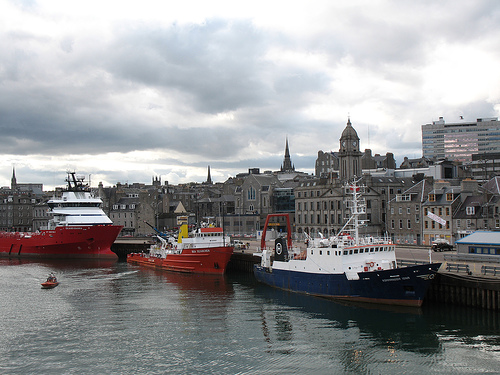Aberdeen
Referred to as the ‘Granite City’ because of the wide use of the stone as a building material, Aberdeen sits where the Rivers Don and Dee flow into the North Sea. The city developed quickly and had its own castle by the 1100’s, as well as a leper house, a market and a friary, closely followed by a school and a hospital. Like many other cities in Scotland it has had something of a turbulent history, with fires and invasions as well as the Black Death, yet the city always managed to recover and continue to grow. Growth was due in part to the importance of the city as a commercial port. As well as the income from trade the city also relied on shipbuilding and fishing for its revenue. During the 1400’s the catch of choice for the fishing vessels had been salmon, but by the 1820’s the focus was definitely on whaling and herring fishing.

A City Built on Industry
The ship building industry in the city began in 1790, focussing on vessels that were to be used in the part itself like fishing vessels and whaling boats through to steamer and coal transports. The shipyards here were still active right up until 1988 and the history of the city’s maritime heritage is on display in the Aberdeen Maritime Museum, which covers the time period from the very earliest days through to the development of the North Sea Oil Industry. Another important industry in the city was brewing, with 157 different breweries in operation across the city at its peak, as well as three whiskey distilleries no one ever went short of a drop of beer or a dram of whiskey.
Modern Day Aberdeen
Aberdeen can easily be described as a city of contrasts, due in part to its complex history and origins. The main streets of the city with their impressive granite buildings have weathered the centuries well and the harbour is still a bustling hive of activity. Regular ferries leave the harbour to take passengers and supplies to the outlying islands of Shetland, Lerwick and Kirkwall. The city has seen the development of new buildings to house the offices of those involved in the oil industry in recent years and the city has taken on a new lease of life. Despite the hard exterior of an industrial city Aberdeen is still a place of beauty, with several miles of undeveloped beach along its rugged coastline, which is home to several species of sea birds and other creatures.
Tourist Attractions
Many of the more attractive parts of the city can be found between Union Street and the harbour area. The older part of Aberdeen provides the visitor with buildings of historical interest as well as the St Machar’s Cathedral. If you were to take a short drive out of the city centre you could visit the pretty harbour town of Stonehaven, or the beautiful Dunnottar Castle which perched upon its seemingly precarious rocky promontory is almost entirely surrounded by the waters of the sea.
If you enjoy castles there is a castle tour called the Aberdeenshire Castle Trail which will take you to an amazing thirteen different castles in the region. Aberdeen and the surrounding area have taken the crown in the Britain in Bloom competition many times, so as you would expect there are plenty of parks and glorious open spaces to enjoy. One thing to bear in mind though if you are coming to the city though, whilst the beach is unspoilt and undeveloped the city actually lies further geographically north than Moscow, so bikinis will not be required!


